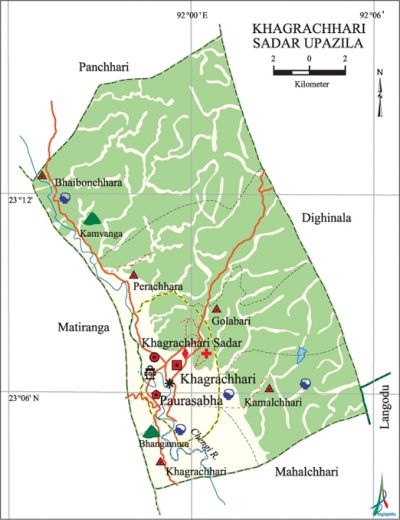Khagrachhari Sadar Upazila
Khagrachhari Sadar Upazila (khagrachhari district) area 297.91 sq km, located in between 23°00' and 23°21' north latitudes and in between 91°55' and 92°00' east longitudes. It is bounded by panchhari upazila on the north, mahalchhari upazila on the south, dighinala and langadu upazilas on the east, matiranga upazila on the west.
Population Total 111833; male 58366, female 53467; Muslim 36599, Hindu 28590, Buddhist 44574, Christian 2049 and others 21. Indigenous communities such as chakma, marma, tripura and Tanchanga' belong to this upazila.
Water bodies Main river: Chengi.
Administration Bemrachai Chowdhury established the Khagrachhari Town in 1860. Khagrachhari Thana was formed in 1968 and it was turned into an upazila in 1984.
| Upazila | ||||||||
| Municipality | Union | Mouza | Village | Population | Density (per sq km) | Literacy rate (%) | ||
| Urban | Rural | Urban | Rural | |||||
| 1 | 5 | 13 | 246 | 69434 | 42399 | 375 | 56.3 (2001) | 45.2 |
| Municipality | ||||||||
|
Area (sq km) |
Ward |
Mahalla |
Population |
Density |
Literacy rate (%) | |||
| 13.04 (2001) | 9 | 71 | 47278 | 2981 (2001) | 71.0 | |||
| Upazila Town | ||||||||
|
Area (sq km) |
Mouza |
Population |
Density |
Literacy rate | ||||
| 50.25 (2001) | 3 | 22156 | 362 (2001) | 48.6 | ||||
| Union | ||||
| Name of union and GO code | Area (acre) | Population | Literacy rate (%) | |
| Male | Female | |||
| Kamalchhari 47 | 14020 | 6953 | 6690 | 54.1 |
| Khagrachhari 63 | 7680 | 4662 | 4475 | 48.8 |
| Golabari 25 | 2304 | 5667 | 5324 | 49.2 |
| Perachhara 75 | 10114 | 5655 | 5510 | 48.1 |
| Bhaibonchhara 15 | 26880 | 9846 | 9773 | 37.2 |
Source Bangladesh Population Census 2001 and 2011, Bangladesh Bureau of Statistics. Historical events A group of armed cadre of the Shanti Bahini formally surrendered their arms (consequent upon the chittagong hill tracts peace accord, 1997) at the Khagrachhari Stadium on 10th February 1998 and returned back to normal life after nearly two decades of insurgency.
War of Liberation The biggest encounter of the freedom fighters of the upazila with the Pak army during the War of Liberation is known as the Khagrachhari operation carried out by a joint troop of two companies of the Indian allied forces and about 130 freedom fighters. More than 30 Pakistani soldiers were dead and/or wounded in the encounter and being defeated, the fled from the area.
For details: see খাগড়াছড়ি সদর উপজেলা, বাংলাদেশ মুক্তিযুদ্ধ জ্ঞানকোষ (Encyclopedia of Bangladesh War of Liberation), বাংলাদেশ এশিয়াটিক সোসাইটি, ঢাকা ২০২০, খণ্ড ২।
Religious institutions Khagrachhari Jami Mosque, Baitul Sharaf Jami Mosque, Lakshmi Narayan Mandir (1939), Shiva Mandir, Khagrapur Church.

Literacy rate and educational institutions Average literacy 57.1%; male 63.2%, female 50.4%. Noted educational institutions: Khagrachhari Government College (1974), Khagrachhari Government High School (1957), Khagrachhari North Khobongpodia Government Primary School (1905).
Cultural organisations Library 1, club 38, theatre group 1, women's organisation 12, stadium 1, cinema hall 1, tribal cultural institute 1.
Tourists spots Alu Tila, Kamvanga, Bhanga Mura.
Main sources of income Agriculture 42.43%, non-agricultural labourer 12.51%, commerce 11.97%, transport and communication 2.38%, service 17.64%, construction 1.80%, religious service 0.28%, rent and remittance 0.27% and others 10.72%.
Main crops Paddy, ginger, turmeric, potato, nut, vegetables.
Extinct or nearly extinct crops Varieties of paddy.
Main fruits Mango, blackberry, jackfruit, pineapple, papaya, banana, litchi.
Fisheries, dairies and poultries Poultry 12.
Communication facilities Pucca road 145 km, semi-pucca road 70 km, mud road 175 km.
Extinct or nearly extinct traditional transport Palanquin, horse carriage, bullock cart, elephant cart.
Noted manufactories Saw mill, ice factory.
Cottage industries Goldsmith, blacksmith, weaving, potteries, wood work, bamboo work.
Hats, bazars and fairs Hats and bazars are 3, fairs 2, most noted of which are Khagrachhari Bazar and Shiva Mela.
''Main exports ' Banana, pineapple, jackfruit, papaya.
Access to electricity All the wards and unions of the upazila are under rural electrification net-work. However 52.0% of the dwelling households have access to electricity.
Sources of drinking water Tube-well 78.3%, tap 1.7% and others 20.0%.
Sanitation 61.9% of dwelling households of the upazila use sanitary latrines and 35.4% of dwelling households use non-sanitary latrines; 2.7% of households do not have latrine facilities.
Health centres Hospital 1, health centre 5, family planning centre 3, maternity clinic 1, diagnostic centre 9.
NGO activities Operationally important NGOs are brac. [Suvra Jati Chakma]
References Bangladesh Population Census 2001 and 2011, Bangladesh Bureau of Statistics; Cultural survey report of Khagrachhari Sadar Upazila 2007.
